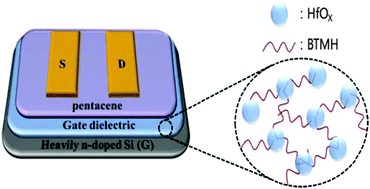Low-voltage pentacene thin-film transistors using Hf-based blend gate dielectrics
Abstract
High-performance pentacene thin-film transistors operating at low voltages were fabricated using hafnium (Hf)-based blend gate dielectrics. Crosslinked HfOx/1,6-bis(trimethoxysilyl)hexane blend (CLHB) dielectric films were prepared by varying the ratio of HfOx and 1,6-bis(trimethoxysilyl)hexane (BTMH), and the resulting films were deposited by solution-processed sol–gel chemistry. p-Type pentacene was deposited on the dielectric films using the neutral cluster beam deposition method. The dielectric properties and morphologies of the films were systematically investigated with respect to the relationship between the compositions of blend dielectrics and device performance. In comparison to the pristine HfOx-based OFETs, as the BTMH molar ratio increased, the leakage current, capacitance, dielectric constant and trap density of the interface states decreased, leading to an increase in the CLHB-based transistor performance such as increased hole-carrier mobility and current on/off ratio and a decrease in subthreshold swing. The OFETs demonstrated similar device performance at high HfCl4 : BTMH molar ratios of 1 : 0.5 and 1 : 0.8. At the molar ratio of 1 : 0.5, the OFETs operating under −4 V had μh,avgeff = 1.6 cm2 V−1 s−1 and Ion/Ioff = 2 × 105 with the corresponding leakage current and capacitance of ∼2 × 10−7 A cm−2 at 2 MV cm−1 and ∼137 nF cm−2. The performance enhancement was found to be closely correlated with the blend dielectrics.


 Please wait while we load your content...
Please wait while we load your content...